Unit 10 - Origins
Content
- MYP10u10.1 - The structure of the universe
- MYP10u10.2 - Structure of the Earth
- MYP10u10.3 - Gravity, the Sun and Moon
- MYP10u10.4 - The origins of life
- MYP10u10.5 - Asexual and sexual reproduction
- MYP10u10.6 - Males and females
- MYP10u10.7 - Animal reproduction
- MYP10u10.8 - Variation and evolution
- MYP10u10.9 - Population and over-population
- MYP10u10.10 - Now test yourself
Scheme of work
10.1 - The structure of the universe
The universe is big...
- Earth and moon
- Planets, planetoids, asteroids and the solar system
- The sun
- Other suns
- The Galaxy and milky way
- The universe
Check your understanding
- List the main levels of structure from Earth to the universe.
- What is the difference between a galaxy and a solar system?
- Why is it difficult to observe the full scale of the universe?
10.2 - Structure of the Earth
Our observable Earth is what we see on the surface, continents, countries, seas and oceans. We observe that the geography of our planet is variable with many different ecosystems, ranging from tropical rainforests to deserts, oceans to icy wastes.
It is up to us to try and explain this variation and various theories have been proposed historically.
How do scientists arrive at theories? On what do they base their ideas?
Historical ideas
Let's consider some historical theories about the stucture of the Earth, Sun, Moon and planets.
1. The Earth is a flat disc with a roof made of holes through which light shines.
2. The Sun is a fiery chariot ridden across the sky by a god called Apollo.
3. The Earth is a sphere at the centre of everything and everything revolves around it.
4. The Sun is at the centre of everything and we orbit around it.
5. The moon is made of green cheese.
How can science help us to address these questions?
Our current model
The earth is thought to consist of several layers of matter. Why do we think this?
- Solid core made of an iron/nickel alloy
- molten outer core consisting of liquid iron/nickel
- The mantle, consisting of very hot soft rock
- The crust (where we live)

Check your understanding
- What are the main layers of the Earth?
- How has science replaced older myths about the Earth's structure?
- Why is the Earth's core thought to be made of metal?
10.3 - Gravity, the Sun and Moon
The Earth's motion
The motion of all of the planets around the Sun is kept in place by the force of gravity. This force acts over vast distances and holds all of the structure of the universe together.
The Earth and all of the other planets orbit around the sun in elliptical orbits. An ellipse is like a slightly elongated circle.
This means that the Earth is further away from the sun during part of its orbit and closer during another part. This is responsible for hotter summers in the southern hemisphere.
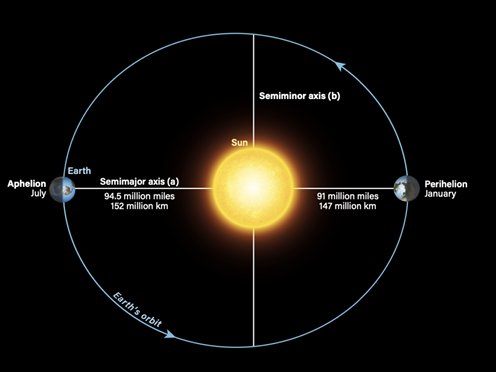
The seasons
These are caused by the Earth rotation on a axis that is tilted. This means that the northern hemisphere is closer to the sun during June than it is during December.
This causes the seasons.

Moons
Many of the planets have moons, although not all. The Earth is locked into rotation with our moon and always faces the same side.
The moon is lit up by sunlight giving rise to the phases of the moon.
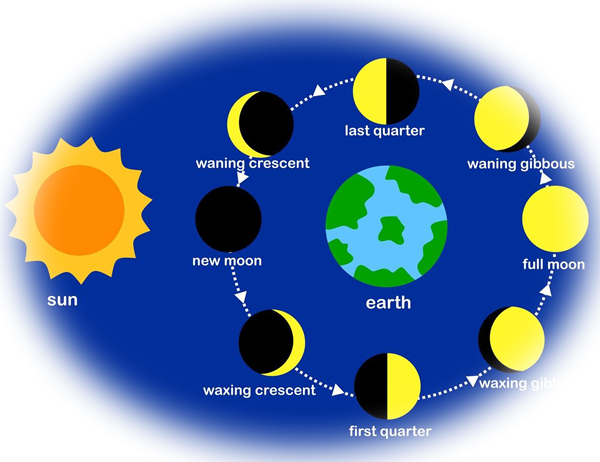
Many of the other planets also have moons. Mars has two, Phobos and Deimos, while Saturn and Jupiter have many moons.
Tides
The rotation of the moon around the Earth causes the tides. There are two high tides and two low tides per day. The Sun's gravity also has an effect on the tides, but this is less powerful. When the two effects, Sun and Moon act together, this gives rise to very high tides (Spring tides).
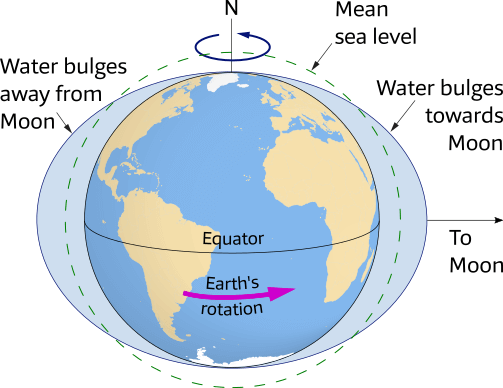
Check your understanding
- Why does the Earth orbit the Sun?
- What causes the seasons on Earth?
- How do the Sun and Moon affect tides?
10.4 - The origins of life
In the previous lesson, we explored the role of gravity, the Sun, and the Moon in shaping our planet and its natural rhythms. Now, we turn our attention to a deeper question: how did life itself begin on Earth?
What do we mean by "life"?
Life refers to organisms that can carry out processes such as movement, reproduction, response to environment, growth, respiration, excretion, and nutrition — often summarised as MRS GREN. All life as we know it is based on carbon chemistry and requires water.
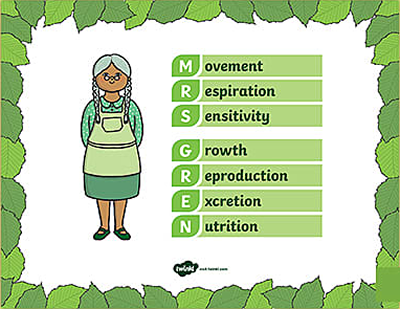
Example
Even tiny bacteria meet all the MRS GREN criteria, while things like viruses challenge the definition of life — they need a host to reproduce.
Where did life come from?
Scientists believe life on Earth began around 3.5–4 billion years ago. There are several ideas about how the first living organisms formed. These include:
- Primordial soup theory – Organic molecules formed in Earth's early oceans, possibly with the help of lightning.
- Hydrothermal vent hypothesis – Life began in deep-sea vents where mineral-rich water met heat and pressure.
- Panspermia – Life or the building blocks of life arrived on Earth via comets or meteorites.
Possible locations for the origin of life
Can we create life in the lab?
In 1953, scientists Miller and Urey conducted an experiment simulating early Earth conditions. They showed that simple amino acids (the building blocks of proteins) could form under the right conditions.
Example
The Miller–Urey experiment used gases like methane, ammonia, and water vapour. After running electric sparks through the mixture, they found several organic compounds had formed.
Activity: Explore origin-of-life theories
Assign students different origin-of-life theories and have them present a short poster or slide explaining the theory, supporting evidence, and any open questions. Optionally link with video clips or animations.
Summary
- Life is defined by the ability to carry out essential processes like growth and reproduction.
- Several theories explain how life may have started on Earth, including the primordial soup and hydrothermal vent ideas.
- The Miller–Urey experiment demonstrated how organic molecules might have formed under early Earth conditions.

Life beginning in Earth’s ancient oceans – a key question in science
Check your understanding
- What characteristics define life?
- Describe one theory for how life began on Earth.
- What was the significance of the Miller–Urey experiment?
10.5 - Asexual and sexual reproduction
In the previous lesson, we looked at how life may have first emerged on Earth. Now we explore how living organisms create more of themselves — through reproduction. There are two main types: asexual and sexual.
What is reproduction?
Reproduction is the process by which living organisms produce offspring. Without it, life would not continue. Some organisms reproduce by themselves, while others need a partner.
Example
Yeast, a type of fungus, reproduces by budding — a form of asexual reproduction where a new cell grows directly from the parent.
Asexual reproduction
In asexual reproduction, only one parent is needed. The offspring are genetically identical to the parent — they are clones.
- No need for a mate
- Fast and efficient
- Little genetic variation
- Examples: bacteria, some plants, and simple animals
Hydra reproducing asexually by budding

Mitosis – how asexual reproduction works
Asexual reproduction happens through a process called mitosis, a type of cell division that produces two identical cells. This is how simple organisms reproduce, and how multicellular organisms grow and heal.
- One parent cell divides into two identical daughter cells
- Each new cell has the same DNA as the original
- Mitosis is used in growth, repair, and asexual reproduction
Stages of mitosis – creating genetically identical cells

Example
When a lizard regrows a lost tail, the new cells are made by mitosis. They are identical to the original cells.
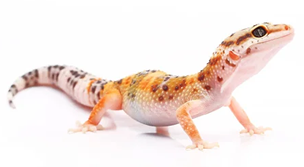
Sexual reproduction
In sexual reproduction, two parents are involved. Each contributes genetic material (usually in the form of sperm and egg), resulting in offspring that are genetically unique.
- Requires a male and female (or two mating types)
- Produces variation in offspring
- Can adapt more easily to changing environments
- Used by most animals and many plants
Sexual reproduction leads to offspring with mixed traits
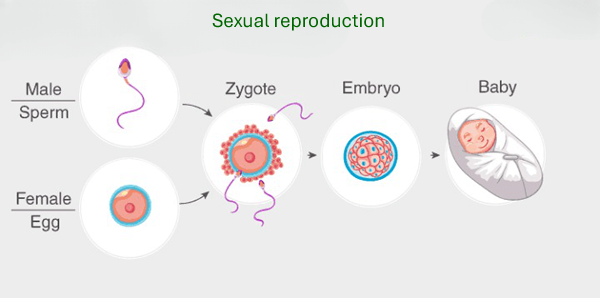
Why does reproduction matter?
Reproduction ensures the survival of species. Asexual reproduction is useful when conditions are stable, while sexual reproduction gives species a better chance of adapting to changes or disease threats.
Activity - Compare and contrast
Ask students to complete a table comparing asexual and sexual reproduction using headings: number of parents, speed, variation, examples. Then choose an organism and describe how it reproduces.
Summary
- Reproduction allows organisms to produce new individuals.
- Asexual reproduction uses mitosis to create clones.
- Sexual reproduction combines DNA from two parents, creating variation.
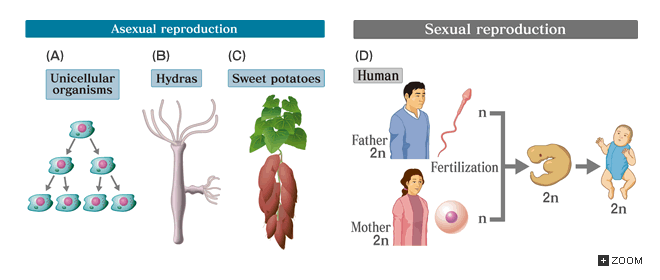
Visual summary of two types of reproduction
Check your understanding
- What is the main difference between asexual and sexual reproduction?
- What is mitosis and how does it support asexual reproduction?
- Which method do you think is better in a changing environment?
10.6 - Males and females
Previously, we explored how living things reproduce using either asexual or sexual strategies. This lesson focuses on how males and females contribute to sexual reproduction, and how special cells — gametes — are formed through meiosis.
Sexual reproduction and sex cells
In sexual reproduction, each parent produces special sex cells called gametes. Males produce sperm cells, while females produce egg cells (also called ova).
- Sperm are small, fast-moving, and made in large numbers
- Eggs are larger, nutrient-rich, and produced in smaller numbers
Human sperm and egg cells shown to scale
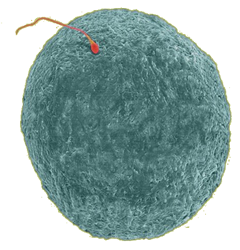
Meiosis – making gametes
Gametes are made by a special type of cell division called meiosis. Meiosis reduces the number of chromosomes by half, so that when fertilisation happens, the correct number is restored.
- One parent cell creates four gametes, each with half the normal chromosomes
- Each gamete is genetically unique — this is why offspring vary
- Meiosis only occurs in reproductive organs
Meiosis results in unique gametes with half the chromosome number
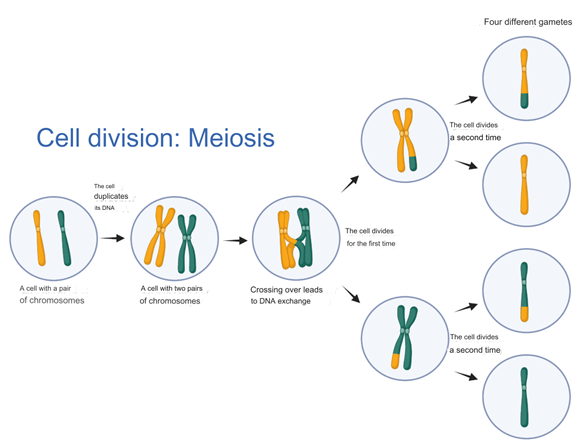
Example
In humans, body cells have 46 chromosomes. After meiosis, sperm and egg cells have 23 each. When they join, the total returns to 46.
Differences in male and female reproductive roles
The reproductive systems of males and females are specialised to support fertilisation and development.
- The male system produces and delivers sperm
- The female system produces eggs and (in many animals) provides a place for the embryo to develop
- In flowering plants, the stamen produces pollen (male), and the carpel contains the ovule (female)
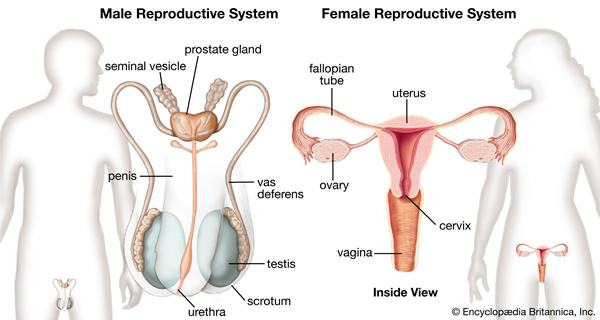
Diagram comparing male and female reproductive systems in humans
Activity: Gametes and meiosis
Students build a model of meiosis using coloured beads or drawings to track chromosome reduction and mixing. Extension: simulate fertilisation by combining gametes to restore chromosome number.
Summary
- Sexual reproduction uses special cells: sperm and eggs
- Meiosis creates gametes with half the chromosome number
- Fertilisation restores the full number and creates variation
Check your understanding
- What is the purpose of meiosis?
- Why are gametes genetically unique?
- What are the names and roles of male and female gametes?
10.7 - Animal reproduction
In the last lesson, we explored the roles of males and females in reproduction. Now we will look at how animals reproduce and how the process can vary widely across species — from insects to mammals to fish.
Internal vs external fertilisation
Fertilisation is the fusion of sperm and egg to form a new organism. In animals, this can happen in two main ways:
- Internal fertilisation: Sperm is transferred directly into the body of the female. This protects the gametes and developing embryo. Example: mammals, birds, reptiles.
- External fertilisation: Gametes are released into the environment, usually water. Fertilisation happens outside the body. Example: fish, amphibians.
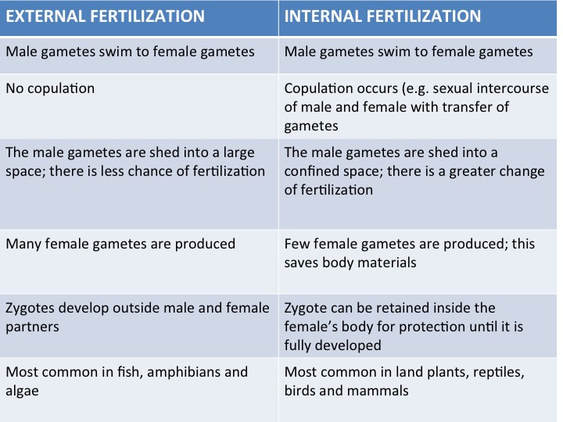
Comparison of internal and external fertilisation
Stages of animal reproduction
Most sexually reproducing animals follow similar stages of development:
- Fertilisation – sperm and egg fuse
- Embryo – a ball of dividing cells
- Foetus – developed structures begin to form
- Birth or hatching – the offspring becomes independent
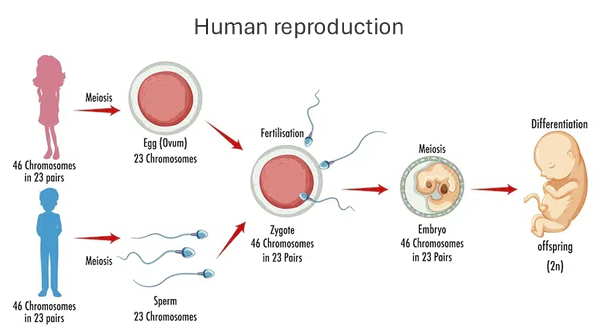
From fertilisation to birth – an overview of mammalian reproduction
Parental care
Some animals invest a lot of time and energy raising their young, while others produce many offspring and leave them to survive on their own.
- Humans, elephants, and birds provide extended parental care.
- Frogs, insects, and fish often do not care for their offspring.
Example
A sea turtle may lay 100 eggs in the sand and then leave. Only a few of the hatchlings will survive to adulthood.

Frog eggs developing in water – an example of external fertilisation
Activity: Animal comparison
In pairs, students research two different animals and compare their reproduction methods, fertilisation type, and level of parental care. Present as a poster or slide.
Summary
- Animals reproduce using internal or external fertilisation.
- Reproduction involves fertilisation, development, and birth/hatching.
- Parental care varies — some animals raise their young, others do not.
Check your understanding
- What is the difference between internal and external fertilisation?
- List the four key stages of reproduction in animals.
- Give one animal that provides parental care and one that does not.
10.8 - Variation and evolution
Variation in species can be generated by genetics. Mutations arise spontaneously and can sometimes lead to genetic disorders or death.
Causes of variation
Individuals in a population are usually similar to each other, but not identical. Some of the variation within a species is genetic, some is environmental - the conditions in which they have developed and some is a combination of both.
Genetic causes of variation
Children generally look a little like their mother and their father, but are not identical to either. They inherit their features from each parent's DNA.
Every sperm and egg cell contains half of the genetic information needed for an individual. Each sex cell is known as haploid, which has half the normal number of chromosomes. When the chromosomes fuse during fertilisation, a new cell is formed, which is known as a zygote. It has all the genetic information needed for an individual, which is known as diploid and has the full number of chromosomes.
Examples of genetic variation in humans include blood group, skin colour and natural eye colour. Biological sex is also an inherited variation - whether you are male or female is a result of genes you inherited from your parents
Environmental causes of variation
Characteristics of animal and plant species can be affected by factors such as climate, diet, accidents, culture and lifestyle. For example, if you eat too much you will become heavier, and if you eat too little you will become lighter. A plant in the shade of a big tree will grow taller to reach more light.
Other examples of features that show environmental variation include:
- scars
- language and accent
- flower colour in hydrangeas as these plants produce blue flowers in acidic soil and pink flowers in alkaline soil
Genetic and environmental causes together
Some features vary because of a combination of genetic and environmental causes. For example, tall parents will pass genes to their children for height. Their children have the genetic potential to also be tall. However, if their diet is poor then they will not grow very well: their environment also has an impact on their height.
Mutation and variation
Extensive genetic variation is contained within any species. This is clearly visible in the domestic dog species.
Different breeds of dogs
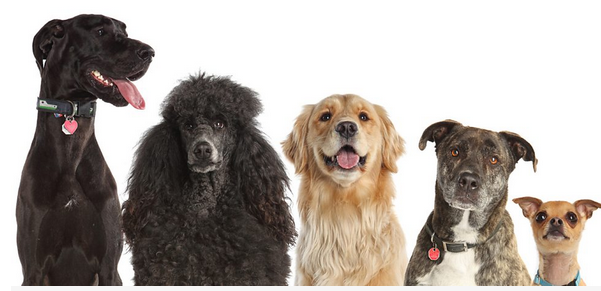
Variation within genes leads to different genotypes, and this can be seen by a different phenotype. Genetic and environmental variation combine together to produce these different phenotypes. All variants arise from mutations and most have no effect on the phenotype.
A mutation is a change in a gene or chromosome. Mutations arise spontaneously and happen continually. A mutation rarely creates a new phenotype, but if the phenotype is suited to a particular environment, it can lead to rapid change in a species.
For example, if a mutation leads to a change, such as feather colouring in birds, this new change may allow those individuals to reproduce more frequently, due to them being more attractive and seen as a more desirable mate. This would result in this phenotype being passed on more successfully than the birds of the same species without the new phenotype.
- Glossary
- gene - a unit of heredity passed from parent to offspring that determines a particular characteristic or trait.
- chromosome - a long, coiled structure made of DNA and protein that carries many genes; it is passed from parent to offspring during reproduction and ensures the inheritance of genetic traits.
- allele - a different version of a gene that can result in variations of a specific trait; individuals inherit one allele from each parent for every gene.
- genotype - the genetic makeup of an organism, representing the specific combination of alleles inherited from its parents for a particular trait.
- phenotype - the observable physical or biochemical characteristics of an organism, determined by its genotype and influenced by the environment.
Natural selection
Natural selection is a process where organisms that are better adapted to an environment will survive and have more offspring. This means their genes are passed on to the future generations. This process is fundamental to the process of evolution.
Charles Darwin was a famous English naturalist, who during his life came up with a theory of evolution. He is associated with the term 'survival of the fittest' which describes how natural selection works, by selecting the best examples of an organism to survive. For example, individuals that are best adapted to their environments are more likely to survive and therefore reproduce.
A famous example of natural selection is the peppered moth.
During the nineteenth century, pollution killed off some of the lichens and soot deposits caused the bark on trees to appear darker. Light coloured moths were no longer camouflaged and were eaten by birds. The dark moths had a better camouflage.

As a result, dark moths had a greater chance of reproducing and passing on the phenotypes, and through this the alleles that made them dark. This led to a gradual increase in the proportion of dark moths until light moths became very rare in industrial areas.
Note that this change was not due to pollution making the moths darker. The dark variety had always existed, but had an advantage when the environment changed.
Check your understanding
- What is the difference between genetic and environmental variation?
- How do mutations lead to new phenotypes?
- Explain how natural selection can change the traits in a population.
10.9 - Population and over-population
In the previous lesson, we explored how animals reproduce and raise offspring. But what happens when populations grow too quickly? This lesson looks at population growth and the effects of over-population on the environment and resources.
What is a population?
A population is a group of organisms of the same species living in a particular area. Populations grow when birth rates are higher than death rates, and decline when the reverse is true.
- Populations are affected by food, water, space, and disease.
- Humans have caused population booms due to technology and healthcare.

Example of exponential population growth over time
What is over-population?
Over-population happens when the number of individuals exceeds the capacity of the environment to support them. This can lead to competition for resources and environmental damage.
- Not enough food or clean water
- Pollution and waste build-up
- Destruction of natural habitats
- Increased disease spread
Example
In parts of the world with dense urban populations and limited sanitation, outbreaks of disease can spread quickly. Overcrowding increases the risk of illness.
Carrying capacity
Every environment has a carrying capacity — the maximum number of individuals it can support without degrading. If a population exceeds this level, resources may run out and the population may crash.
Activity: Investigate human impact
Students research a city or country and analyse its population trends, available resources, and any signs of over-population. They suggest solutions like urban farming, public transport, or education campaigns.
Summary
- A population is a group of the same species in one place.
- Over-population happens when numbers exceed what the environment can support.
- Consequences include pollution, food shortages, and habitat loss.
Check your understanding
- What is a population?
- What causes a population to grow or decline?
- What are some effects of over-population?
- List two consequences of over-population.
- What does 'carrying capacity' mean?
10u10.10 - Now test yourself
Click on the button below to access the self-tests for MYP9 and MYP10.